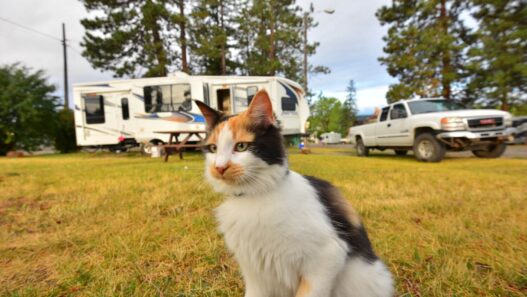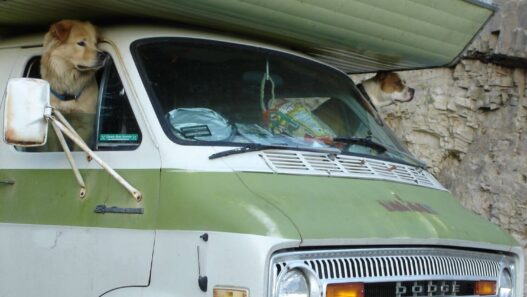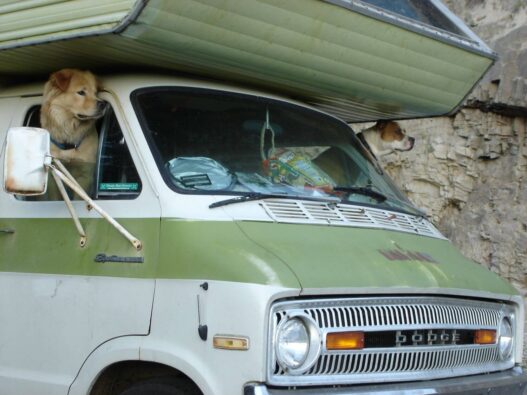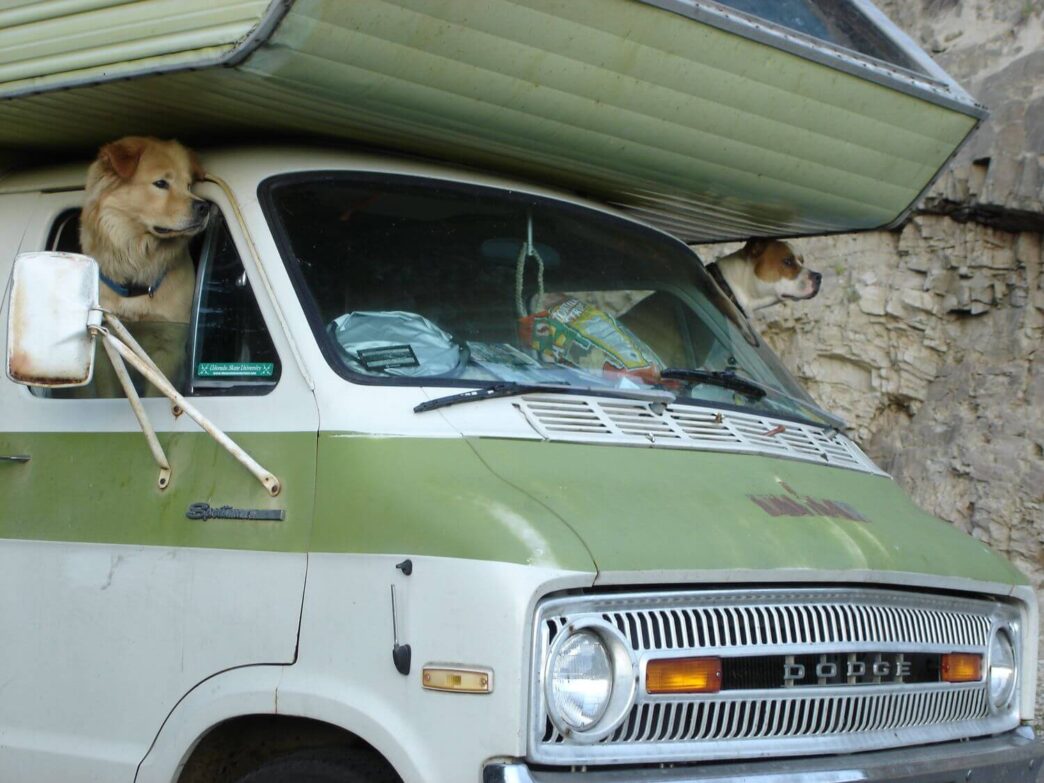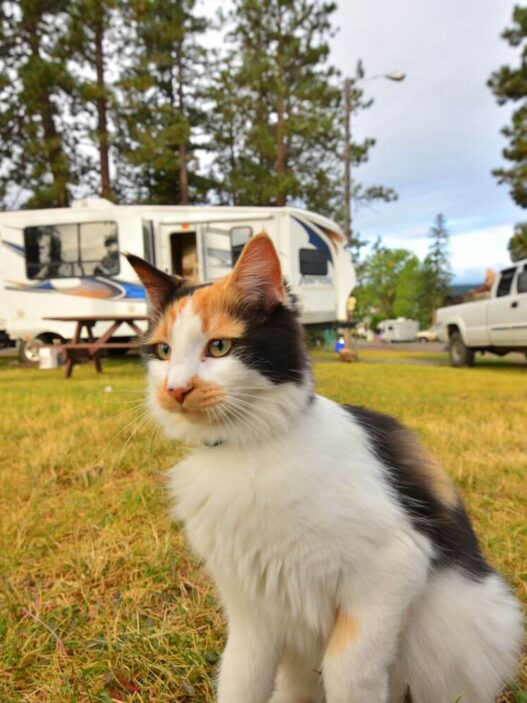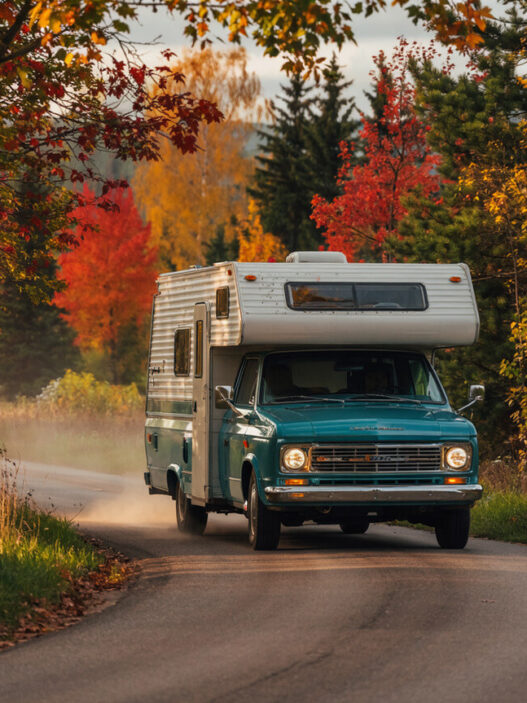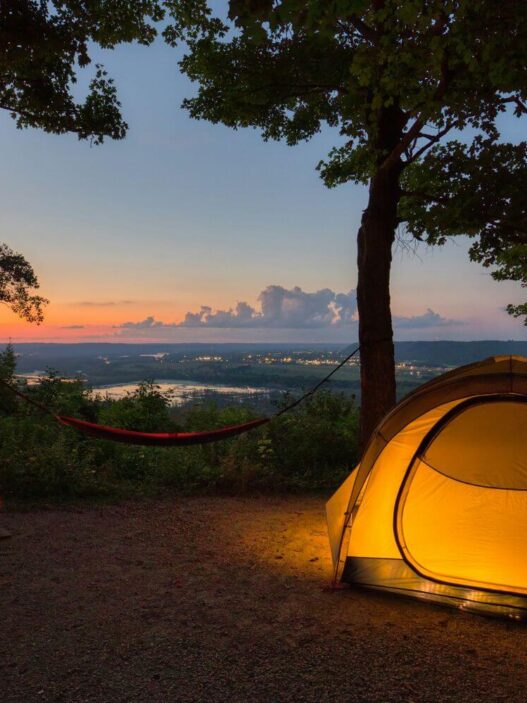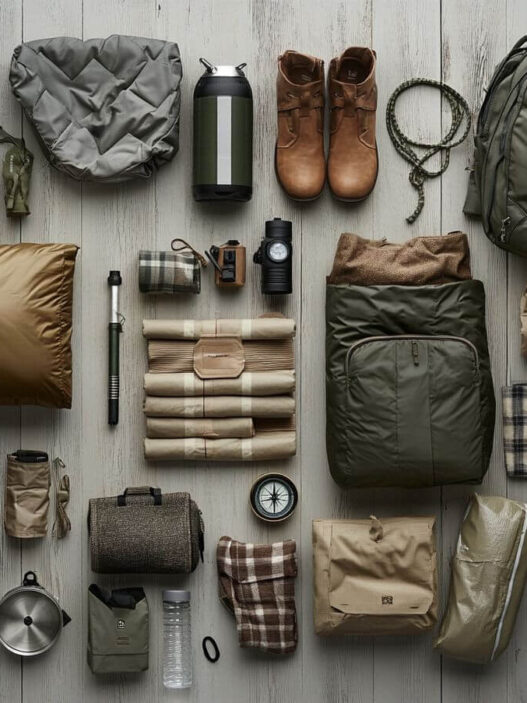Traveling with your dog in an RV combines the comfort of bringing your own home with the joy of having your best friend along for the adventure. These tips will help make your journey safe, comfortable, and enjoyable for both you and your four-legged friend!
1. See Your Vet Before Trips
Make sure your dog’s vaccinations are current before hitting the road. Your vet can advise you about health risks in the areas you’ll be visiting. If your dog gets car sick, ask about medication options that might help. Also consider updating flea and tick prevention if you’re heading to wooded areas where these pests are common.
2. Bring Your Dog’s Medical Papers
Keep your dog’s health certificate and rabies vaccination records easily accessible. Many campgrounds require proof of vaccinations before allowing pets to stay. Having these documents ready saves time at check-in and prevents being turned away because you can’t verify your dog’s vaccination status.
3. Keep Your Dog On A Leash
Always use a leash at campgrounds, even if your dog is well-trained. New environments are filled with unfamiliar scents and distractions that might cause even the best-behaved dogs to wander off. Most campgrounds require leashes anyway, and keeping your dog secured protects them from wildlife encounters and prevents them from disturbing other campers.
4. Make Sure Your Dog Has ID
Ensure your dog wears a collar with current ID tags and has a microchip with updated contact information. If your dog gets lost in an unfamiliar area, proper identification greatly increases the chances of a happy reunion. Many RVers include their cell phone numbers and mention they’re traveling on temporary tags.
5. Keep Your Dog Safe While Driving
Secure your dog using a harness or crate while the RV is in motion. Loose pets can cause dangerous distractions for the driver and may be injured during sudden stops. A proper restraint system keeps everyone safer on the road. Your dog may resist at first but will typically adjust to the routine after a few trips.
6. Know Where To Find A Vet Everywhere You Go
Research veterinary clinics along your route and save contact information for emergency vets in each area you visit. When you arrive at a campground, ask for local vet recommendations. Many RV parks maintain lists of nearby pet services. Having this information ready before an emergency occurs can save valuable time if your dog needs medical attention.
7. Bring Your Dog’s Regular Food And Water
Pack plenty of your dog’s usual food and bottled water to prevent digestive issues. Sudden diet changes often cause stomach upset, which is especially uncomfortable in an RV. Bring more food than you think you’ll need in case you can’t find your brand on the road. Water from unfamiliar sources can also cause digestive problems, so familiar water helps maintain your dog’s routine.
8. Help Your Dog Get Used To The RV
Introduce your dog to the RV gradually before taking long trips. Start with short visits to the parked RV, offering treats and praise. Progress to brief drives around your neighborhood, gradually increasing trip duration as your dog becomes comfortable. Bringing familiar bedding helps make the RV smell like home and reduces anxiety during travels.
9. Give Your Dog Plenty Of Exercise
Regular exercise helps dogs adjust to RV travel. Take morning and evening walks to help burn off energy. After long drives, dogs need to stretch their legs and explore. Look for dog parks along your route where your dog can run off-leash safely. A well-exercised dog is more likely to settle down contentedly in the RV during travel and rest times.
10. Never Leave Your Dog In A Hot RV
RVs can heat up rapidly in the sun. If you must leave your dog alone, ensure the air conditioning is functioning properly. Consider using a temperature monitor you can check remotely from your phone. Have a backup plan for cooling if the power fails. On very hot days, it’s safer to take your dog with you or arrange for pet sitting than to risk heat-related illness.
11. Pack Extra Dog Supplies
Bring backup supplies including extra leashes, plenty of waste bags, and spill-proof bowls. Pack towels for muddy paws, any medications your dog takes regularly, and basic first aid items for pets. Having extras prevents the inconvenience of trying to find replacements in unfamiliar areas. A well-stocked pet supply kit makes travel more comfortable for everyone.
12. Take Lots Of Breaks
Stop every few hours during travel days so your dog can stretch, relieve themselves, and drink water. Plan your route with suitable rest areas in mind. Regular breaks benefit human travelers too, making everyone more comfortable. These stops also provide opportunities for brief exercise that helps dogs remain calmer during the driving portions of your journey.
13. Use Gates When Setting Up Camp
A portable gate or fence keeps your dog contained while you’re busy setting up your RV. Setting up camp requires concentration, and dogs may try to explore or escape through open doors during this process. A temporary enclosure gives your dog some freedom while keeping them safe and preventing them from interfering with setup tasks.
14. Have A Backup Plan For Hot Days
Don’t rely solely on your RV’s air conditioning system. Power outages and mechanical failures happen. Keep battery-operated fans, cooling mats, and plenty of fresh water on hand. Know where nearby pet-friendly, air-conditioned places are located in case you need an emergency cooling option. Some campgrounds offer shaded dog areas that can be more comfortable during hot weather.
15. Be A Good Neighbor
Respect fellow campers by controlling barking and always cleaning up after your dog. Being considerate helps maintain positive attitudes toward pets at campgrounds. If your dog tends to bark at passersby, consider setting up camp away from high-traffic areas. Good pet etiquette ensures campgrounds remain pet-friendly for future visitors.
16. Bring Their Favorite Toys
Pack familiar toys and some new ones to keep your dog entertained. Boredom can lead to problem behaviors in the confined space of an RV. Puzzle toys with treats inside provide mental stimulation on rainy days. Chew toys can help anxious dogs relax in new environments. Rotating toys helps maintain your dog’s interest throughout your trip.
17. Check If Dogs Are Allowed At The Campsite
Verify pet policies before arriving at campgrounds. Many places have weight limits, breed restrictions, or limits on the number of pets allowed. Some attractions near your destination may not allow dogs at all. Researching pet-friendly activities in advance helps you plan an enjoyable trip for everyone. A quick phone call can prevent disappointment upon arrival.
18. Stick To Routines
Maintain your dog’s regular schedule for feeding, walks, and bedtime as much as possible. Consistency helps dogs feel secure despite changing locations. Use the same commands and rules you follow at home. Bringing your dog’s regular bed or crate provides a familiar sleeping space that helps reduce anxiety in new surroundings.
19. Be Ready For Weather Changes
Pack appropriate gear for various weather conditions you might encounter. Bring a dog jacket for cool evenings and rain gear for wet weather. Consider dog booties if you’ll be in very hot or cold areas where ground surfaces might be uncomfortable for paws. Some light-colored or thin-coated dogs benefit from pet-safe sunscreen on exposed skin areas when spending time outdoors.





